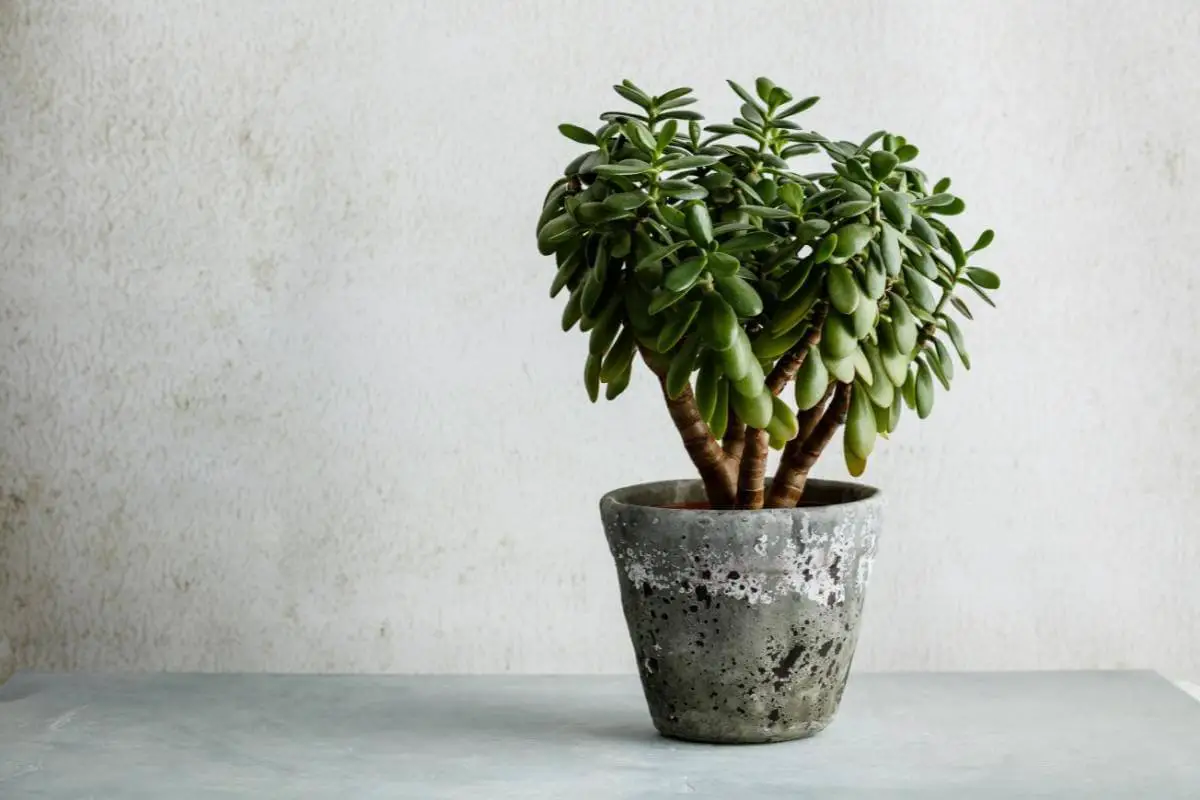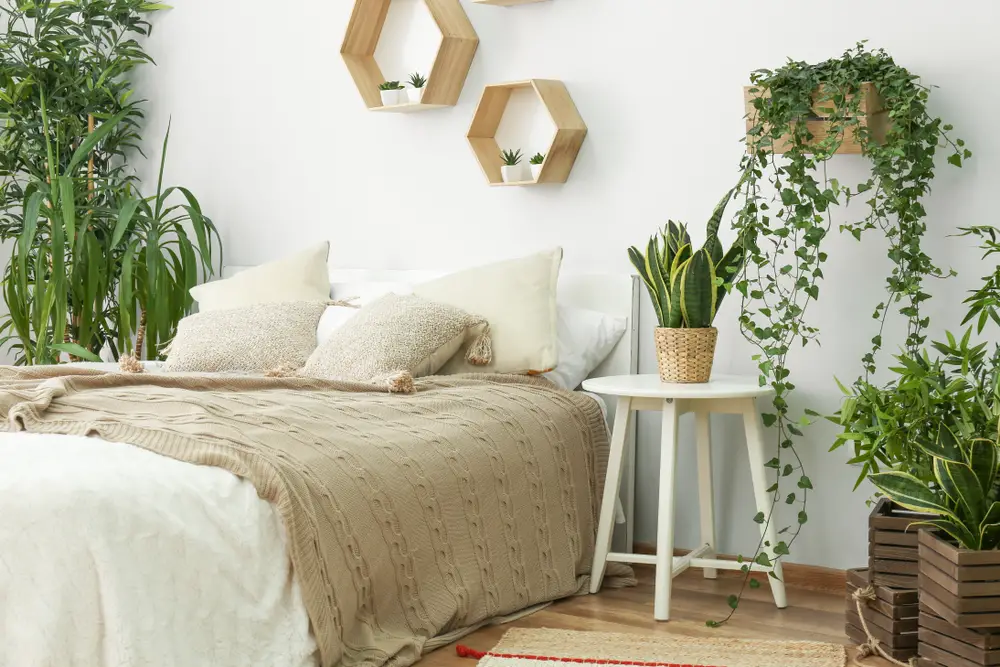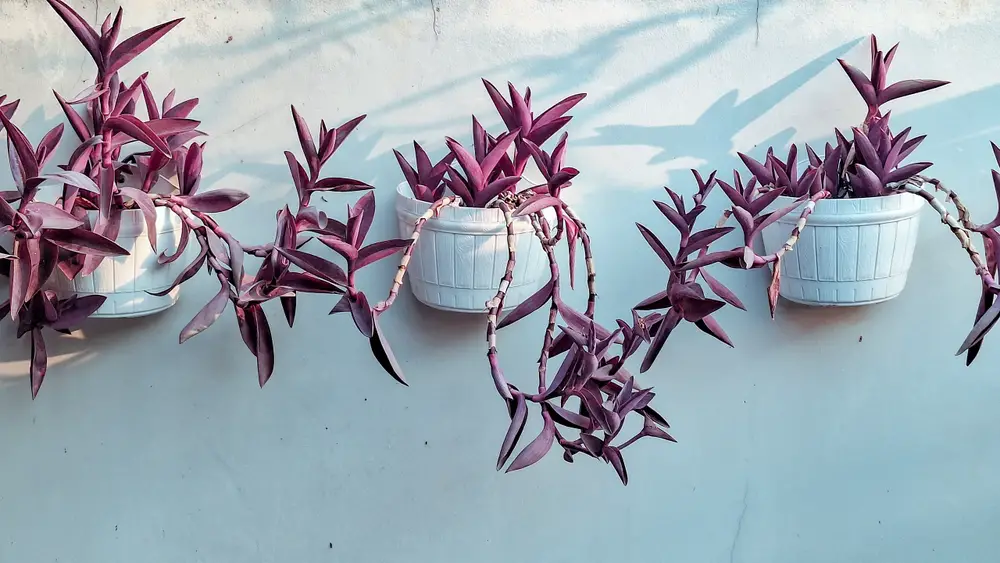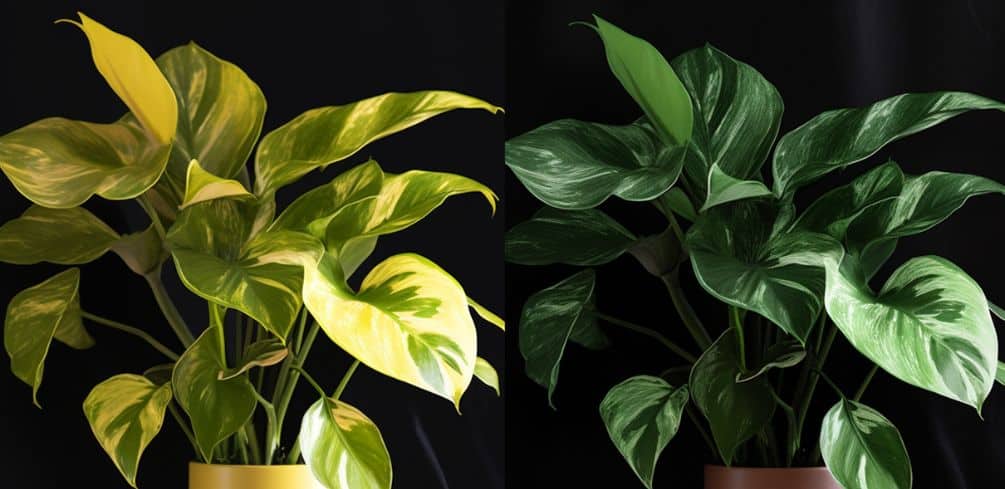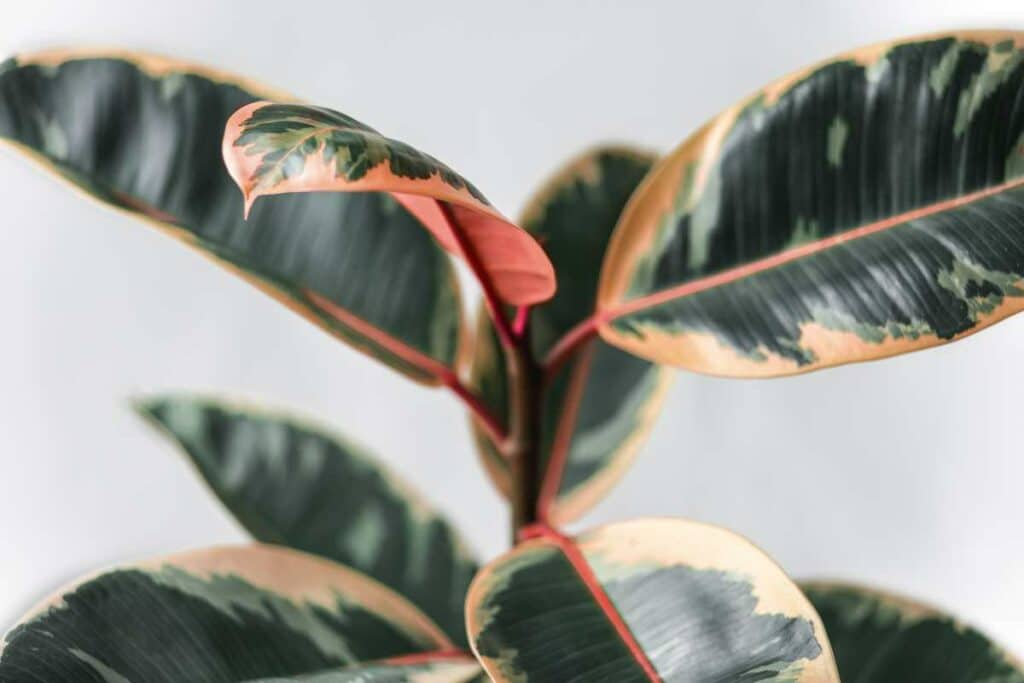Crassula ovata, better known as the jade plant or money plant is one of the world’s most popular houseplants.
It is associate with prosperity and good fortune, and its longevity makes it a favoured gift that may even be passed between generations!
This plucky succulent is just as easy on the wallet as it is to care for. Its resilience makes it an ideal housemate for even the most inept or frankly negligent of gardeners.
If you are the new owner of a jade plant or are looking to grow or propagate these distinctive plants this complete guide to growing and caring for jade plants will equip you with everything you need to know to have jade plants flourish in your home.
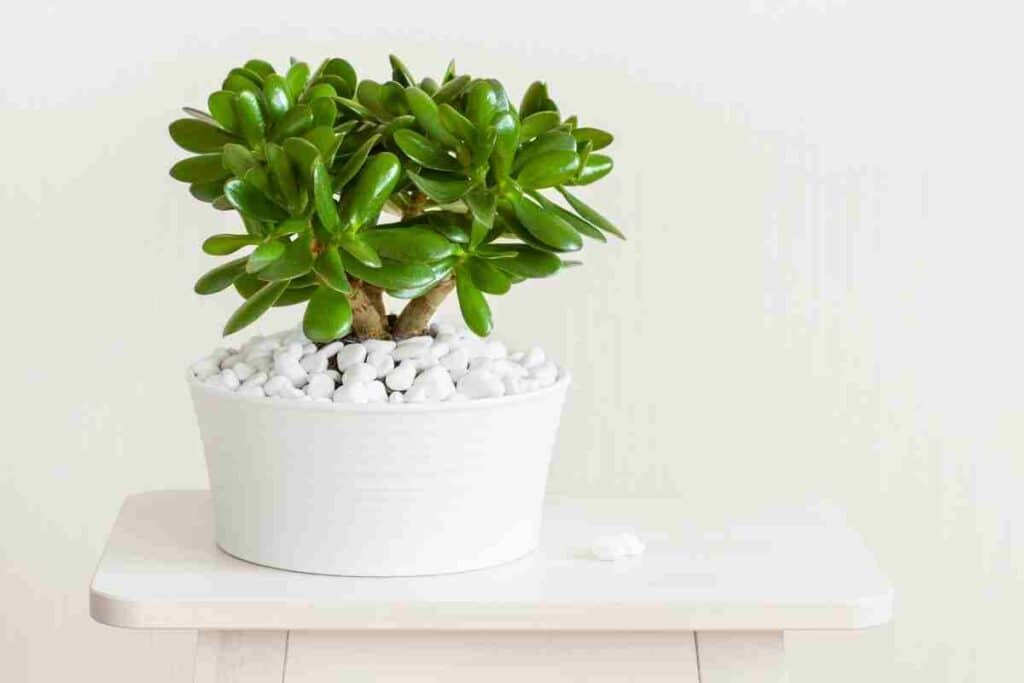
We will cover the key aspects of jade plant care with lots of tips and tricks right down to where to place these plants in your home!
All About the Jade Plant
If you are wondering “what is a jade plant?”, it’s likely that you have encountered this incredibly common houseplant by one of its other names.
Jade plants are a type of perennial evergreen succulent plant with thick coin-shaped, fleshy leaves that are engorged with moisture. It is native to southern Africa where it can still be found in particularly arid regions of Namaqualand, Kwazulu Natal, the Eastern Cape and Mozambique.
In its natural setting, this plant can be found among other succulents in valley-thicket vegetation or growing on an arid rocky hillside.
The Many Names of the Jade Plant
Because jade plants are found all over the world it is likely you have encountered this distinctive fleshy leaved plant.
It goes by many names including the Afrikaans and Khoi names as well as some nicknames that may also be used for other plants.
The Latin name for the jade plant comes from the word “Crassus” meaning thick or fat and “Ovata”, or egg-shaped, describing the leaves.
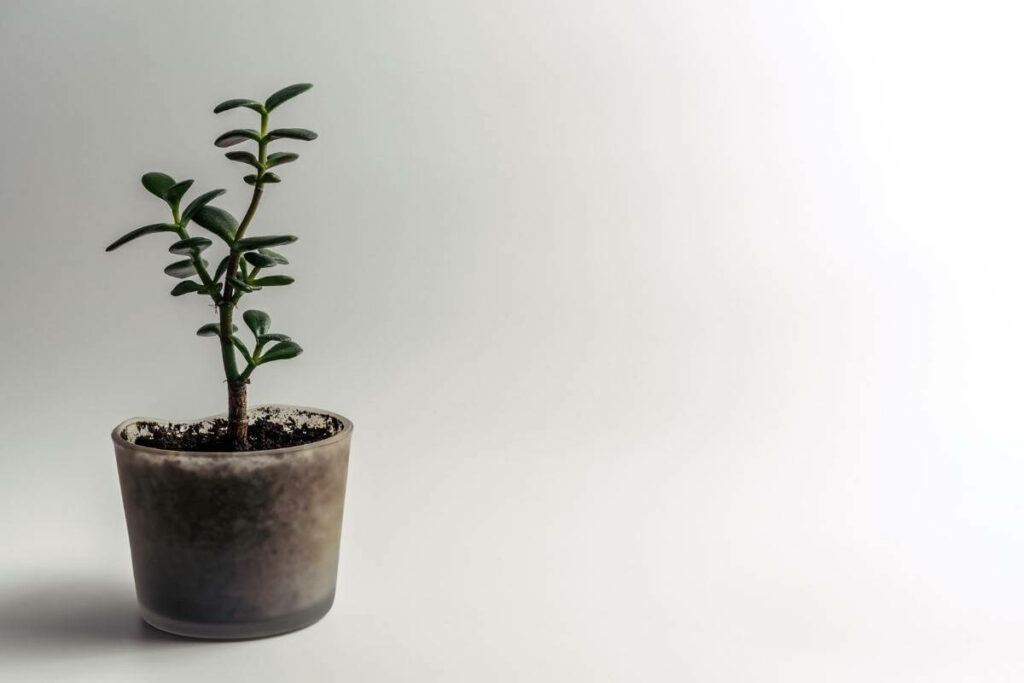
Here are some of the other names of the jade plant:
- Lucky plant
- Baby jade
- T’karkai
- Money tree
- Dollarplant
- Friendship plant
- Annual honesty
- Beestebul
- Kerky
- Plakkies (Khoi)
- Umxhalagube
- Friendship tree
- Silver dollar plant
- Kerkij
- Kerky bush
- Pink joy
- Japanese rubber plant
- Chinese rubber plant
- Japanese-Laurel
- Cauliflower-Ears
What Do Jade Plants Look Like?
The jade plant is highly familiar to most people due to its paired shiny jade-green leaves that grow on thick sometimes scaly branches.
The leaves sometimes carry a reddish or yellow tinge depending on the variety of the plant and the thin bark of the jade plant easily peels of leaving cracked stripes as the plant grows.
Though it is sometimes described as a tree, the jade plant is an evergreen shrub, achieving a maximum height of 2.4 metres (7.87 feet).
The trunk and branches of this plant are not lignified – the jade plant is flesh and succulent throughout.
The coin-shaped leaves of the money plant can grow up to 10 centimetres (3.93 inches) in diameter with a wedge shape that can be 5 millimetres (0.19 inches) thick at its maximum.
Also, the leaf pairs are arranged at right-angles to one another at a distance of one or two centimetres along the branches of the plant.
The Flowering of the Jade Plant
You may not have seen it before, but jade plants do flower!
Jades produce beautiful clusters of small pinkish-white star-shaped flowers. The flowers are grouped in compact, rounded bunches.
Once pollinated they become small capsules that hold numerous seeds.
Coinciding with the colder and shorter days of winter, these pleasantly scented hermaphrodite flowers emerge in masses on stalks.
You can induce flowering in a jade plant by keeping it in a small pot and cutting back on watering.
Nice Tip: Cool temperatures will help your jade plant to bloom.
How Many Different Types of Jade Plants are There?
Jade plants are part of the Crassulaceae (stonecrop, orpine) family of plants with over 300 succulent species ranging from mossy carpet-like plants to mature shrubs and small trees.
C. ovata is one of the larger plants in the family and is very hardy and long-lived, capable of achieving a life span of 100 years with the right TLC!
Crassula Ovata has a variety of cultivars that vary in leaf colour or shape as well as plant size.
Here are some of the common ones:
- Crosbys Compact, also known as Crosby’s Red, Red Dwarf or Crosby’s Dwarf. It is characterised by the strong red colouration of its leaves and smaller branches giving the plant a miniaturised appearance.
- Monstruosa, also known as spoon jade, or hobbit jade is a variety with a shrubby appearance and tubular leaves which also have a red tint. It is more tree-like with a thickened and coarsened trunk.
- Hummels Sunset has beautiful multitoned leaves. The yellow and red tips become very prominent in strong sunlight.
- Tricolor, is a shrub that is noted for its variegated leaves which have a creamy yellow and white colouration and requires very little water to thrive.
- ET’s Fingers is a quirky variety with tubular red suction cup-tipped leaves.
- Undulata is a jade plant variety that has curled leaves.
How to Care for Jade Plants
The jade plant owes its popularity to its ease of cultivation and minimal care.
As it comes from harsh arid environments with minimal rainfall, the jade plant is well-adapted to surviving with minimal water.
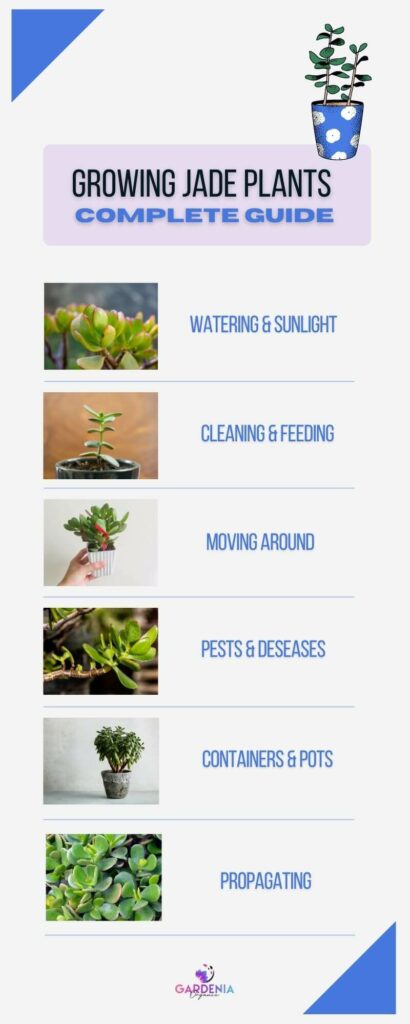
This succulent is an efficient water preserver, with a majority of the plants mass made up of water.
Water is stored in the jade plants leaves and stems meaning that they aren’t so reliant on you for watering.
In Fact: Jade plants need minimal watering in the summer and even less through the winter.
How Often Should You Water Jade Plants and How?
This is definitely a plant that you do not need to make a fuss about.
Overwatering the jade plant will cause it to develop leaf fall and root rot. But some care is required as underwatering will also damage or even kill a jade plant.
Here are some key points for watering jade plants correctly:
- Water is needed most when the jade plant is actively growing. This is usually in the spring and summer. Even then the jade plant should only be watered when the soil is superficially dry. This usually means a watering frequency of once every two weeks or even monthly.
- A jade plant may become dormant in winter. The slowing of the growth of the jade plant means that even less watering is needed during the winter months. The soil of the money plant can be left to dry out completely between waterings, especially if the plant is mature.
- Leaf shrivelling and leaf drop are signs that the jade plant needs more water. Brown spots may appear on the leaves of a dehydrated plant.
- Full, glossy leaves indicate that the plant is adequately watered.
- An overwatered plant may have soft waterlogged leaves.
- Using a toothpick is a smart way of checking if your jade plant needs water. Like a dipstick, you can push the toothpick into the soil and pull it out. If it is stained with moist soil, you do not need to water the plant.
- Do not spray jade plants or get water on their leaves. The humidity created can cause the leaves to rot.
Does a Jade Plant Need Direct Sunlight?
A jade plant requires up to 6 hours (and a minimum of 4 hours) of direct sunlight daily, depending on the season.
If a jade plant does not get enough sunlight it will start to reach towards lights sources and become leggy.
Suitable positions for indoor jade plants include sunny spaces with indirect sunlight or south and western-facing windows.
Decent sun exposure brings out the reddish tinge on the money plants leaves or even turns the leaves yellow. This colour change should prompt owners to add some shade.
As mentioned above it is hardy enough to withstand light frosts.
Indoor Jade Plant Care
Jade plants are suited to indoor environments as room temperature, between 18 and 24 degrees Celsius (65 to 75 degrees Fahrenheit), is ideal for growth.
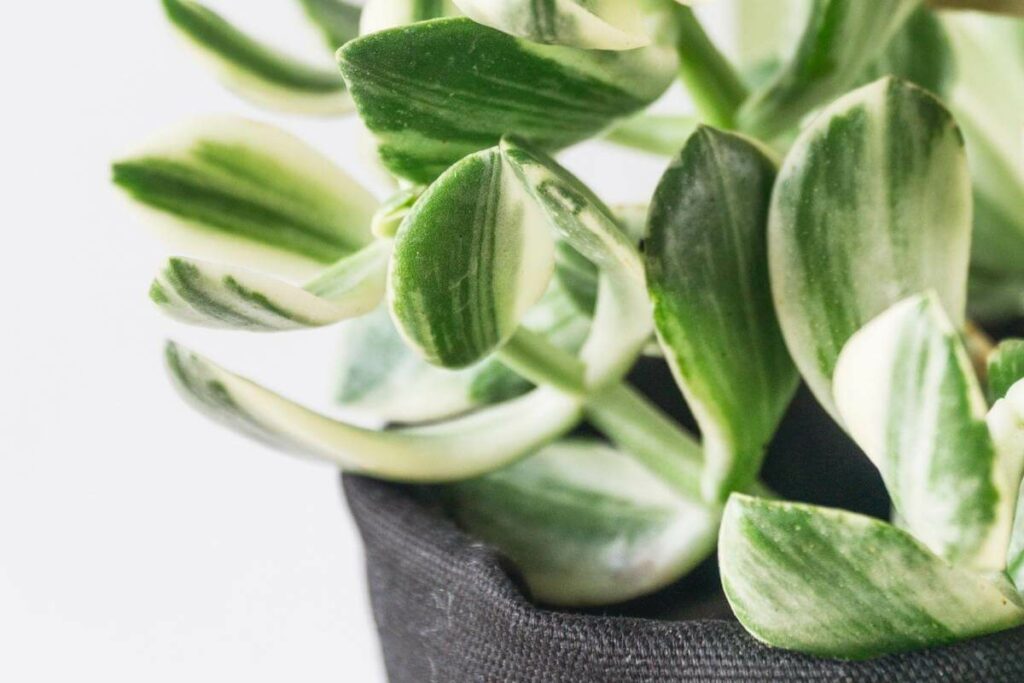
In the winter, cooler temperatures are preferable, but plants should be kept away from cold windows and draughty areas.
Indoor jade plants can be potted in soil that offers good drainage, or a specialist soil for cacti and succulents. Drainage is the jade owners friend, as it will help prevent jade plants roots from becoming waterlogged.
Works Well: Use a porous substrate on a gravel base with drainage holes in the plant pot.
What Size Container for Jade Plants and What Type Is Best?
Jade plants don’t need a massive amount of space in a plant pot.
Your choice of pot need only be slightly bigger than the plant itself. If you have a 5-inch diameter jade plant, a 6-inch pot should accommodate its growth for at least a year or two.
If you want your jade plants to grow, re-potting them to a larger pot during the spring will encourage them to grow larger.
Terracotta is great for potting jade plants. The terracotta is porous and can absorb some excess water, which helps to prevent waterlogging.
Pots should have holes in their base and sit on a tray. Always keep the base tray of your jade plant empty. This will help to prevent root rot.
Jade plants can also be tray-planted and miniaturised for a beautiful Bonsai effect.
Excellent Advice: The Bonsai technique is effective because jade plants will respond well to the targeted pruning. Jade plants are often chosen for learning Bonsai.
Do Jade Plant Leaves Need to Be Cleaned?
Indoor jade plants can attract significant dust build-up on their leaves that can be cleaned at regular intervals.
Leaf cleaning shouldn’t be neglected as a coating on grime on the leaf will prevent photosynthesis, respiration, and transpiration which can damage the plant’s health.
A soft lint-free and non-abrasive cloth can be used to clean jade leaves with water. This should be done gently so that the leaves are not damaged.
Leaf shine products should not be used as they can block the pores of the jade leaves. The cloth should be soaked in warm water and wrung out to wipe clean the leaves of your jade plant.
If there is excessive build-up, a very dilute soap solution can be used to lift the grime.
Keep your jade leaves dust-free by regularly dusting them with a feather duster. This can be done as often as you water your jade plant.
Outdoor Jade Plant Care
In warm, dry climates, jade plants can thrive outdoors.
For year-round outdoor growth, a jade plant is best suited to drier climates like Zone 10 (southern US states, Mediterranean countries).
In more temperate climates, jade plants should be grown in containers so they can be moved indoors when temperatures drop.
Autumn and winter should prompt a jade plant to be moved indoors as they can only tolerate the lightest of frosts and a minimum temperature of 10 degrees Celsius (50 degrees Fahrenheit).
If they remain outside they will become cold damaged.
Look Out: As they are sap-rich, outdoor jade plants are a target for a variety of pests and should be checked regularly for infestation.
How to Move a Jade Plant Outdoors
Moving a jade plant outside should be attempted in spring or early summer when the weather is warm and the sunlight is not at its maximum.
Being outdoors in warm weather will benefit a jade plant as it will have access to good sunlight. Transitioning a houseplant to being outdoors can take time.
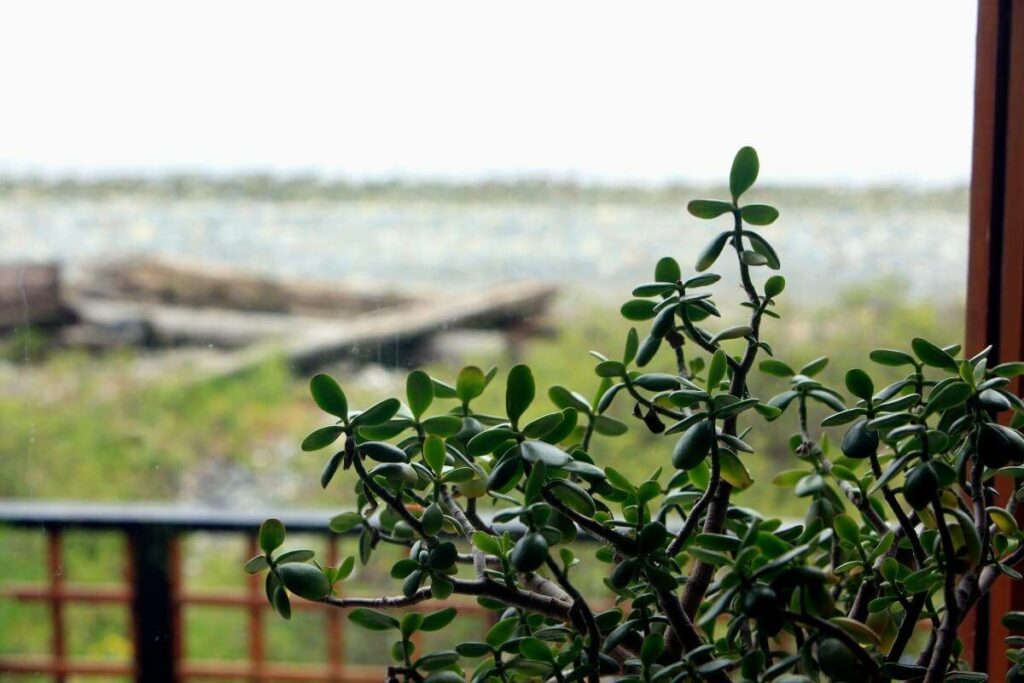
One of the biggest risks to a jade plant that is being moved outdoors is intense sunlight that may burn a plant that is used to indoor lighting.
This can be prevented by gradually introducing the jade plant to outdoor sunlight for short periods to build tolerance, just like hardening off other plants that are moved outside.
Should I Feed My Jade Plant?
The native environment of the jade plant is hostile and nutrient-poor, so feeding is not a priority for this plant.
Feed them very sparingly with a liquid fertilizer for houseplants or succulents. This can be diluted and added to one of their regular watering during the spring and summer months.
They only need to be fed every two to four months.
Propagating Jade Plants
Propagation of the jade plant is quick and simple.
You can successfully propagate money plants from a single leaf!
Cuttings provide the best results and mimic the jade’s natural means of reproduction. In its natural habitat, shed jade plant branches fall to the ground, develop roots and carry on growing.
Cuttings can be treated with rooting powder and then planted in clean soil. A jade plant cutting establishes roots over about four weeks if temperature and humidity are optimal.
If roots have developed, you will know the cutting has started to grow by the emergence of new leaves.
How to Grow Jade Plants from Seed
Jade plants can be successfully grown from seeds, which are widely available for purchase.
For the best results, jade plant seeds should be sown in the Spring or Summer.
Getting them started is easy by following these steps:
- Jade plant seeds should be grown in a soil mixture that is specifically formulated for succulents with good drainage. Fill a 4-inch pot with this soil, placing up to three seeds an inch apart in the centre on the surface of the pot.
- Alternatively, money plant seeds can be sown directly outdoors in a sunny area in loamy soil with good drainage. One or two seeds should be sown in each location with a space of at least one foot between plantings. The seeds should not be covered.
- Jade plant seedlings need to be watered on a weekly basis with just enough water to moisten the soil. Maximise sunlight and if sowing indoors the pot can be coved with a clear plastic bag with holes in it, to retain moisture.
- Once the jade plants have two or three leave they are ready to pot-on. The strongest seedlings should be removed and placed in their own pot to continue growing. For outdoor jade plants, thin the plants to the strongest seedling in each desired location.
- Growing jade plants should only be watered when the soil is dry. This can be as little as once every two to three weeks. Overwatering will cause root rot.
- The jade plants can be fed a general-purpose liquid fertilizer once every two months. Use according to the instructions and add to your regular watering, concentrating the feed on the root zone of the growing plant.
- Once the jade plant has developed branches, you can begin to prune and shape the jade plant. Pruning encourages the development of the mainstem, improving the plant’s ability to sustain multiple branches and leaves.
- Be vigilant for pests, especially with plants grown outdoors. The common pests of the jade plant and their management are explained further on.
How Do You Harvest Jade Plant Seeds?
Once jade plants have flowered and the flower heads have dried up, the seed pod will develop.
These can be harvested for jade plant seeds which are extremely fine.
Pests of the Jade Plant
Jade plants are not only largely kept indoors but are also sap rich.
This makes them a magnet for a variety of parasites that feed on their juices. Pests can quickly multiply on money plants leading to stunted growth and leaf loss.
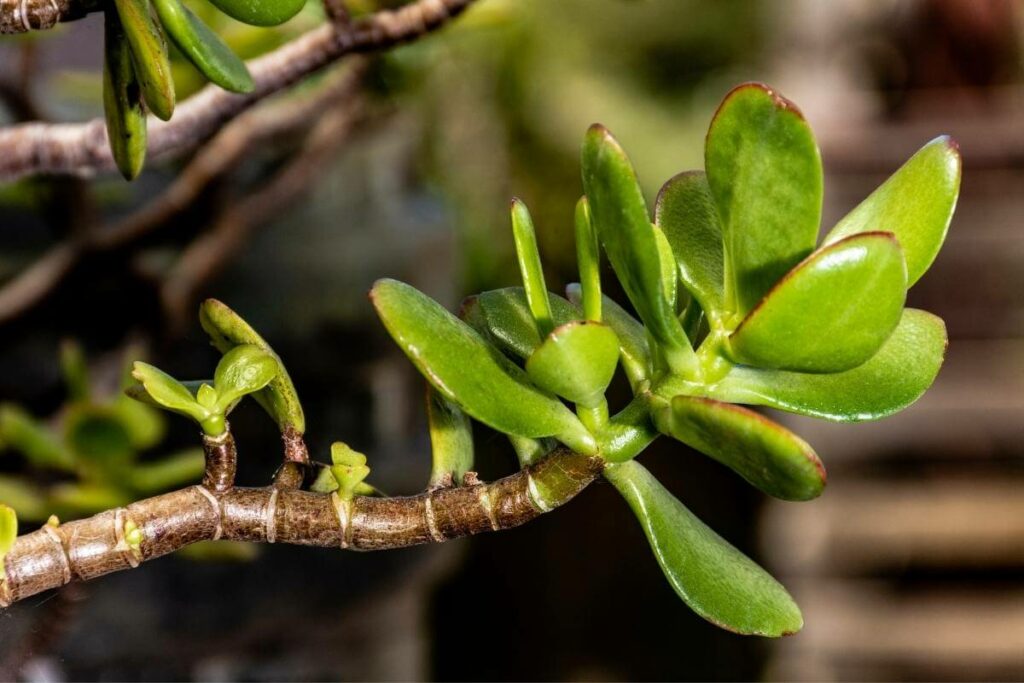
Here are some of the common pests of the jade plant.
Scale Insects
Scale insects are flightless soft-bodied insects that attach themselves to a money plant by piercing the plant with their mouthparts and sucking its juices under pressure.
As they colonize the plant they produce waxy scales and excrete a sugary substance known as honeydew. These insects are usually removed by direct application of rubbing alcohol.
If you would like to know other effective methods of eradicating scale insects from your jade plant, read the helpful article “Are scale insects harmful to humans?” that covers the main eradication methods.
Spider Mites
Spider mites also love the warm conditions of an indoor jade plant and will rapidly multiply while feeding on the sap of the jade plant, puncturing its cells to feed.
These tiny, rust-coloured mites are under a millimetre in length and look like spores on the plant with a web-like covering enmeshing their eggs.
Female spider mites live up to a month and produce 20 eggs per day, so without control, a household money plant can become quickly overwhelmed.
Try This: The main treatment for spider mites is rubbing alcohol.
Mealybugs
Mealybugs love to such the juices of a jade plant and can be found massed on the underside of leaves or where the leaves attach to the stem.
Their appearance is like a white waxy and granular mass. Repeated treatment with rubbing alcohol on cotton wool can remove them without damaging the jade plant.
Are you tackling mealybugs on your jade plant? Worried if they could harm you?
Read the article “Are Mealybugs Harmful to Humans or Plants?” that explains all you need to know about mealybugs and how to tackle them successfully on your jade plant.
Aphids
Aphids will also suck sap from a money plant.
They are larger than most other pests and will be easy to spot on your plant. Aphids also secrete honeydew, which is capable of causing black powdery mildew.
For jade plants, rubbing alcohol is the main strategy for eradication.
The rubbing alcohol can also be mixed with a very small amount of dish soap for added potency and emulsifying any waxy coatings that the aphids use for protection.
Jade Plant Diseases
Humid conditions, pests and other factors that weaken jade plants leave them susceptible to several diseases.
Here are some of the most commonly encountered ones.
Powdery Mildew
Powdery mildew is precipitated by pests that suck the plant juices and produce a sugary Honeydew excreta.
Removal of the pests and cleaning the plant with a solution of baking soda and vinegar can help. Affected foliage should be pruned.
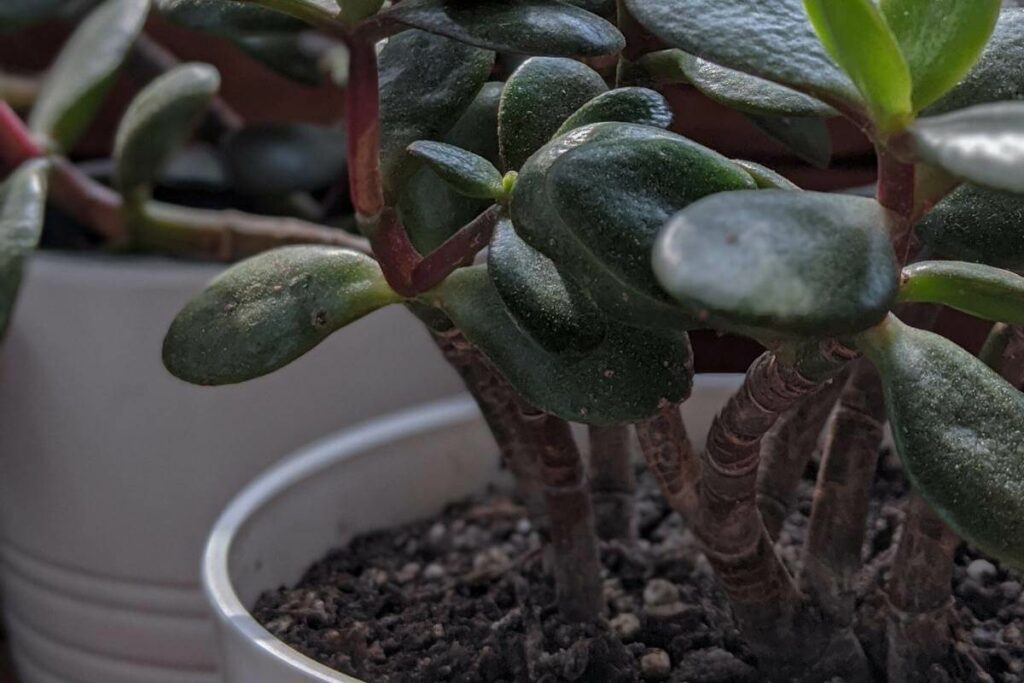
Bacterial Soft Rot
This disease manifests in the collapse of jade plant branches and leaf stems. The collapsed plant tissue is mushy.
It is caused by an organism called Erwinia. Soft rot spreads quickly and usually leads to a jade plant being discarded.
Signs of root rot include:
- Stunting of the plant
- Wilted leaves and branches
- Leaf discoloration
Root rot is caused by Phytophthora organisms which are a type of fungus.
In an overwatered plant, the spores from this organism can spread and destroy the plant roots leading to dieback of the foliage and certain death of the plant.
If a jade plant develops root rot it should be discarded as this disease can spread to other houseplants.
Black Ring Disease
Black ring disease is a viral infection that leads to a jade plant developing black target lesions or spots on the underside of its leaves.
It is spread by insects that feed on the plants, meaning pest eradication is a first-line defence.
Good To Know: Black ring disease does not kill jade plants. The affected parts of the plant can be removed and the plant repotted in uncontaminated soil.
How to Save a Dying Jade Plant
The reputation of the jade plant for being hardy means that watering issues, diseases and pests may go undetected for a prolonged period and the jade plant starts to die.
Reviving a dying jade plant is not easy and often damaged plants will end up in the compost heap quite quickly.
It is, however, possible to revive a dying jade plant if the damage or disease process is not too extensive.
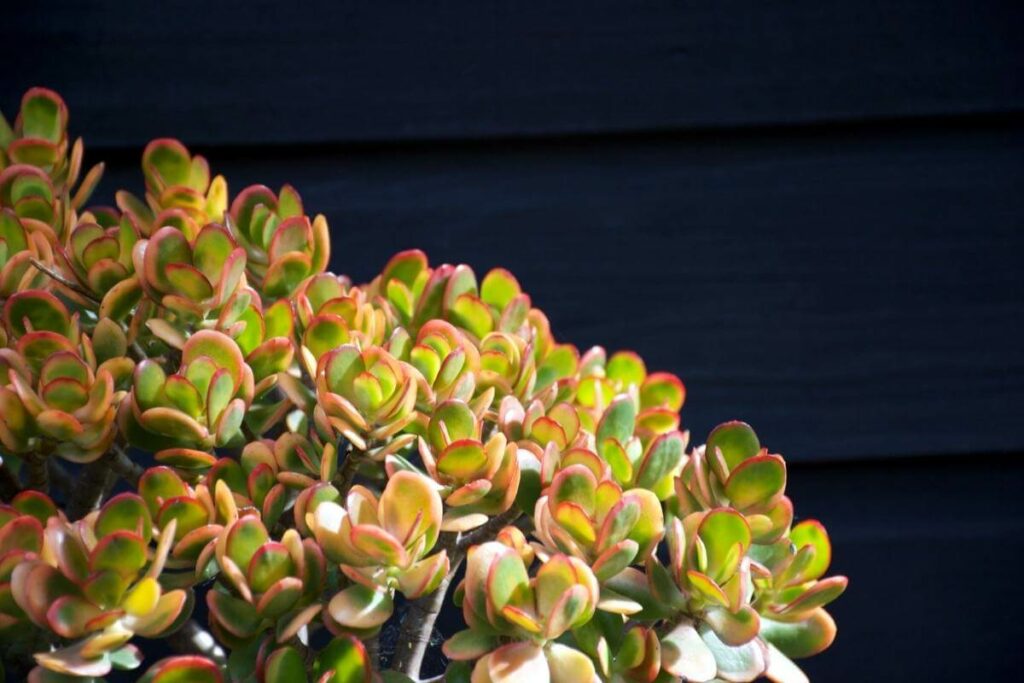
The approach you use will depend on the underlying problem in the plant, most commonly, overwatering, underwatering or disease.
If a Jade Plant Is Dying Because of Overwatering?
Overwatering a jade is easily done.
The key signs in the plant are brown and black spots on the leaves, as well as the plant becoming yellowed and soft due to the excess water it has taken up.
Reviving the jade is all about bringing it back to its optimal conditions, firstly by reducing the moisture it has to cope with.
- Watering needs to be scaled right back.
- The jade can be repotted in new soil with good drainage
- Scale back the size of pot used for the jade, down to a size that simply holds the root ball with little excess soil.
- The pot used for the jade should have drainage holes and a base tray
If a Jade Plant Is Dying Because of Underwatering?
If you have frankly forgotten your jade (easily done), you may find that it has dropped its leaves.
Drought stress in jade plants produces wrinkly foliage and droopiness.
This can be remedied quickly by placing the jade in a tray of water.
Leave it there for about 10 minutes so that the soil and roots of the jade plant become thoroughly saturated and start to move water into the plant.
Provide the jade with great sunlight and warmth, to stimulate transpiration and further uptake of water from the roots, and ensure that you establish a regime of regular, adequate watering.
If a Jade Plant Is Dying Because of Disease?
Managing disease in jade plants can be tricky as extensive disease or pests can spread to other houseplants nearby.
Quarantining a diseased or infested plant is the first step, to protect other plants. If pests are the cause of disease, these need to be removed, along with affected leaves and branches.
The blade you use to cut diseased parts of the plant should not be used on non-diseased areas of the plant or other plants without sterilization or you risk spreading the disease.
The jade plant can then be cleaned with rubbing alcohol and repotted with fresh soil. The plant should remain quarantined and observed for recovery of growth or a recurrence of the disease.
For The Persistent: The jade may require repeated treatments before pests are fully eradicated. Have a low threshold for discarding plants with root rot or soft rot as these bacteria can spread to other houseplants.
Why Is My Jade Plant Turning Purple?
Though it looks attractive, the development of a purplish colouration to the jade leaves is a sign of stress in the plant.
An abrupt change in conditions like a temperature drop or change in lighting can cause the plant to release anthocyanins that give the jade a purple hue.
Some horticulturalists deliberately stress jade plants to bring out this colour.
If you are concerned consider adjusting the environmental conditions of the jade and ensure it is properly fed and watered.
Are Money Tree Plants Poisonous?
Knowing the toxicity of common houseplants is vital if you have young children or pets in your home.
Because the jade plant is so widespread, it is commonly assumed that it is non-toxic. But jade plants do produce biologically active phytochemicals that can harm humans and animals.
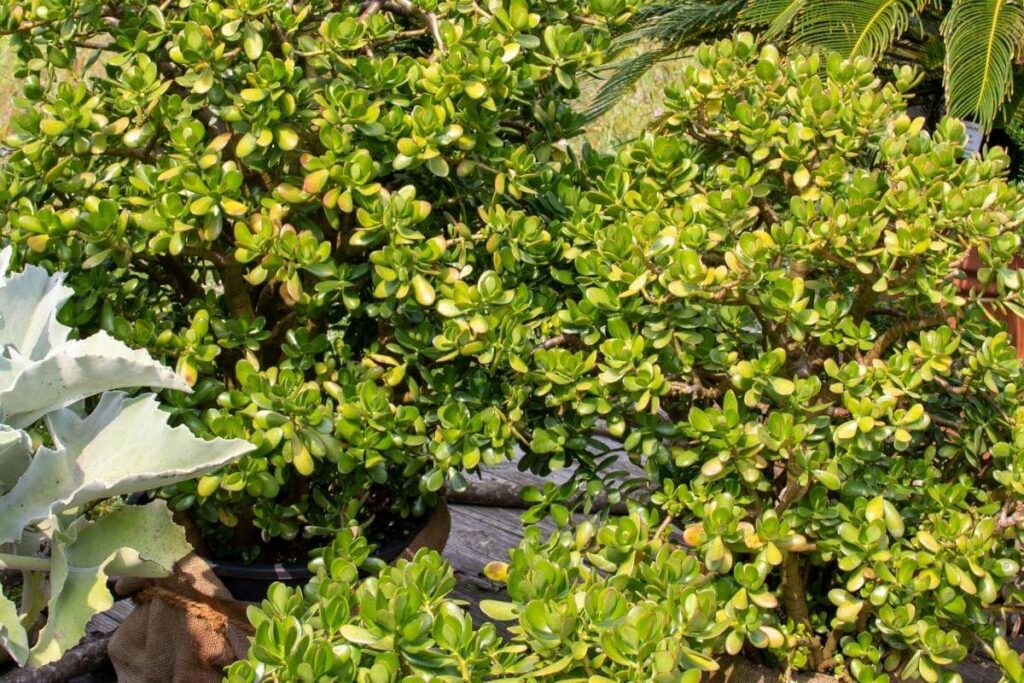
Interestingly, money plants have also been studied for antimicrobial traits as it has been used in Chinese medicine and the traditional medicine of the South African Khoi tribe.
Is Money Plant Poisonous to Humans?
Crassulaceae plants like the jade plant contain cardiotoxins of class similar to digoxin, but for humans, they are only mildly toxic if ingested and irritating to the skin.
The main symptoms from eating the leaves are gastrointestinal irritation with vomiting and diarrhoea.
It should be kept out of the reach of children, who will be attracted to its succulent, rubbery leaves.
Are Jade Plants Poisonous to Cats and Dogs?
Jade plant leaves and stems are more toxic to animals, including dogs, cats and horses who may inadvertently nibble on the succulent leaves of an outdoor plant.
Ingestion leaves animals lethargic and uncoordinated on their legs along with vomiting.
The Americal Society for the Protection of Animals, strongly advises that this plant is kept away from pets.
Final Thought
Now you are equipped with everything you need to know to make your jade plants thrive!
The simplicity and beauty of this humble succulent have an enduring appeal.
It is a straightforward plant to care for and with a little bit of effort, you can enjoy decades of growth and rich foliage from just a single jade plant.
Whether you choose to grow your jade indoors or outdoors, cultivating and caring for the jade plant is extremely satisfying, especially for beginner gardeners.
Stay vigilant for pests, disease and don’t forget to water this cute little plant once in a while!
You May Also Like
- Terrarium Substrate Layers (Complete Guide)
- Herbs Light Requirements Guide: Natural vs Artificial Light
- How Long Do Closed Terrariums Last?
- Philodendron Care, Varieties, And Aesthetic Home Arrangements
- Best House Plants for Low Light – Thriving Indoors with Minimal Sunlight
- 15 Air-Purifying Houseplants That Release The Most Oxygen
- Purple Houseplants: Your Guide to Dramatic Indoor Beauty
- Philodendron Moonlight Vs. Golden Goddess
- How to Revive Your Rubber Plant: 6 Tips to Help Your Rubber Tree Thrive Again
